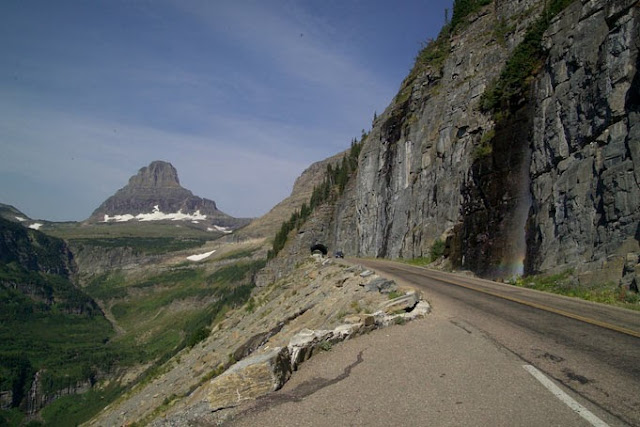A great road is a
great road, but if you’re riding a motorcycle, you’re looking for something
special: twisties, vistas, turnouts, that perfect stretch of smooth tarmac, and
biker-friendly stops that make getting there most of the fun. Here are 10 of
the best roads across America for an unforgettable motorcycle journey:
1. Pacific Coast
Highway (Hwy 1): 1700 miles from Astoria, Oregon to San Juan
Capistrano, California
This undisputed
champion of road trips presents beaches, cliffs, redwood forests, sleepy
seaside towns, hot tub B&Bs, and world-class dining along a ribbon of
winding, undulating road that (between RVs) can provide thrilling sport riding
and contented cruising. Stop at the frequent turnouts, and don’t miss wild
Olympic Peninsula, rustic Big Sur, Hearst Castle, bikini-clad Malibu, or
biker-friendly Seattle, San Francisco, and San Diego.
2. Appalachian
Mountains: 770 miles from Front Royal, Virginia to Deal’s Gap, North Carolina
This four-in-one
magic mountain ride begins with Skyline Drive in Virginia, a 105-mile run along
the ridge of the Shenandoah National Park, conveniently connected with the Blue Ridge Parkway
for 469 miles of smooth roads and sweeping blacktop. Ride east to Tellico
Plains along the Cherohala Skyway (Hwy 28) descending into Tennessee
backcountry. Loop back via Hwys 360 and 72 to Deal’s Gap, and take on the
internationally famous 11 mile Tail of the Dragon and whip through those 318
curves for some bragging rights.
3. River Road, (FM
170): 120 miles from Terlingua to Candelaria, Big Bend, Texas
Farm to Market 170
is all smooth heavenly pavement along the Rio Grande through the Big Bend’s
Chihuahuan Desert ecosystem with its mountains, canyons, badlands, and stunted
forests, and even grandma’s Buick can handle the 17 mile off-road loop through
the Valley of the Gods. But if you’ve got a dual-sport, you’re going to be in
heaven. Once it reopens (progressing well
at the time of writing), you’ll be able to ride on a boat over the Rio Grande
at the Boquillas Crossing for a short jaunt for lunch on the Mexican side of
the border.
4. Going to the Sun
Road: 50 miles in Glacier National
Park, Montana
Before this
two-hour, 50-mile ride over Logan Pass was completed, it took visitors several
days to get through the park, which speaks of its height and contortions. Watch
out for mountain goats and bighorn sheep, and pull over at the Jackson Glacier
Overlook to take in the most spectacular scenery in the park.
5. Beartooth
Highway, (US 212): 68 Miles in Yellowstone
National Park, Wyoming
Squiggle along for
a couple of hours over the highest highway in the Northern Rockies as it twists
and turns its way up to 10,947 feet at Beartooth Pass in Wyoming. Stop to take
in views of glacier-laden peaks, alpine plateaus dotted with lakes, waterfalls,
and lush forests in one of the most rugged areas in the lower 48 states.
6. Highway
12: 124 miles between Bryce Canyon
National Park and Capitol Reef
National Park, Utah
Take a psychedelic
sunset ride into fantastical sandstone rock formations, canyons, deep blue
lakes, and pine forests and all the curves you might expect. Swish along to the
Grand Staircase-Escalante National Monument, Boulder Mountain, and Red Canyon
in Dixie National Forest.
7. Coastal Highway
1: 170 miles from Kittery to Bucksport, Maine
Detours, not
twisties, along Maine’s 3478 miles of coastline is the point here. The oldest
highway on the east coast is dotted with over 60 lighthouses, countless cute
towns, antique shops, lobster shacks, and almost 50 peninsulas to explore. The
highway connects with many other scenic routes, including a ferry ride to Nova
Scotia.
8. Overseas Highway
(Hwy 1), Florida, 100 miles from Key Largo to Key
West
Put your sun screen
on and cruise out onto a narrow stretch of road made of bridges atop a living
reef in the turquoise Straits of Florida sandwiched between the Atlantic and
the Gulf of Mexico. Join the margarita-saturated tourists in tropical paradise
and enjoy the biker-friendly atmosphere. Salt air, sea food, and slow speed get
you onto island time in no time flat.
9. Route 66:
2200 miles from Chicago to Santa Monica
On just about
everybody’s bucket list is Route 66. Ride all 2200 miles of this history lesson
smothered in kitsch, or just grab a slice or two, like the pies you’ll find in
endless supply at the many biker-friendly stops between Chicago and Santa
Monica.
10. The Great River
Road (Hwy 61): 2,552 miles from Itasca State Park, Minnesota to Jackson,
Louisiana
GRR 61 is a single
route created in 1938 to highlight the 10 states bordering the great
Mississippi River from its headwaters in Minnesota to its termination in
Louisiana’s Cajun Country. Local riders from all 10 states flock to ‘their”
section of the road, whether it’s lined with meadows, cypress swamps, thick
forests, limestone cliffs, or wildlife refuges. Industrial areas are easily
avoided.
Carla King is an
adventure travel writer who specializes in riding cranky indigenous motorcycles
around the world. She is author of the Motorcycle Misadventures series of books
and live internet dispatches from the road. Wherever she is, you can always
find her at CarlaKing.com.







